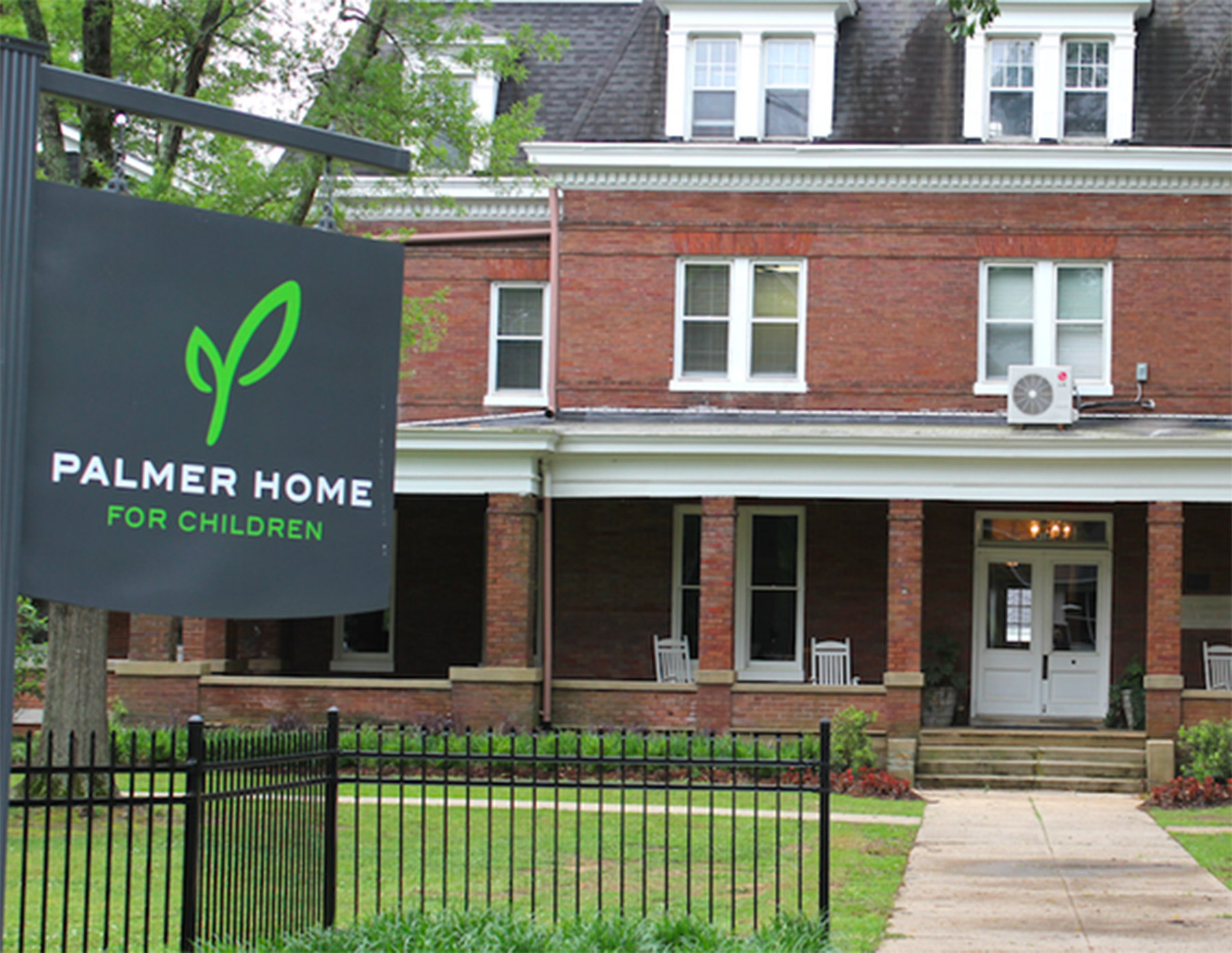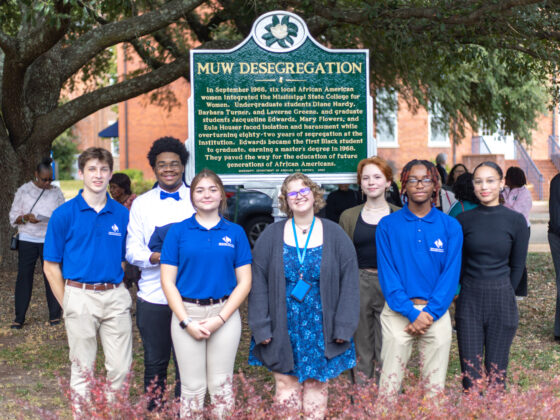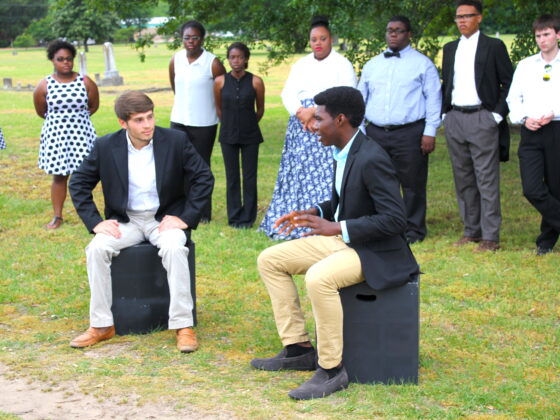We were on the east side of Columbus, Mississippi a few weeks ago, seeing the distressed facilities of a factory that still makes toilet seats. Next stop was an abandoned trouser factory, and then the bricked up marble headstone factory. In between, one of our hosts mentioned that we would pass near the orphanage.
“Orphanage! That is so sad,” I said, envisioning something Dickensian or out of the darker side of Harper Lee. “Actually, the children live very well,” rebutted our host gently.
So I set out the next day to visit the orphanage, which everyone I met in Columbus called the Palmer Home.

One big change that affected the everyday and overall lives of the children came in the 1960s, when the Palmer Home began moving its children out of big traditional dorm-like buildings to on-campus individual homes. This idea, which was new to the times and especially new in the south, was a move toward more family-style living. The cottages, as the houses are quaintly called, were designed for 6 – 8 children to live with a set of houseparents, the overall effect resembling a much more “normal” family life.

My guide around Palmer Home that fine spring day told me a particularly poignant story behind one of the early cottages. In 1967, there was a catastrophic midair collision between a Piedmont Airlines Boeing 727 and a twin-engine Cessna over Henderson, North Carolina. Everyone aboard the two planes was killed, 82 people in all, including three from Columbus: J. Dudley Hutchinson, the owner of a wholesale food company, his son of the same name, and a new employee, C.L. Hutcherson. They did not leave orphans, but they did, in effect, leave a gift to the orphanage, which came in the form of a memorial fund from the people of Columbus. Today that is Hutchinson House, one of the first of the 7 cottages there now.
The main building, called the Lindamood Building, of the Palmer Home looks as grand as many of the private ante-bellum homes that grace Columbus, especially considering it was built as an institution. Lindamood housed children back in the day, and it now houses administrative offices, a big kitchen and a dining room that can hold all the kids.

The residential cottages, long one-story ranch-style in design, are set around the main lawns with a playground, basketball court, and lots of running space.

Horses and stables are off to one side; a baseball diamond and a swimming pool off to another. There is also a gym. When I visited, some boys were playing basketball, and one girl was skipping across the lawn and another was trotting by on a horse. The campus sprawls over 110 acres, amounting to a small farm with vegetables, orchards and 12 big greenhouses, which were abloom with all sorts of flowers, including my favorite gerber daisies.
The farming is a source of revenue for the Palmer Home, from produce they sell at the local farmers’ market to their new venture, a Community Supported Agriculture (CSA) program where people buy a season subscription for fresh produce. It is also a source for the children to learn farming skills and to earn pocket money by working on the farm.

There is also school space on the grounds, where some of the kids are home-schooled. Most, however, fan out to public and private schools around town, whichever seems to be the best match. There is an abundance of supplemental opportunities and support – camping and fishing trips, trips to Disney parks, service trips, tutors, therapists.
I visited one of the cottages, which reminded me of the houses where some of my childhood friends from St. Francis Xavier elementary school in the Chicago suburbs lived. My friends were from big families, 7 or 10 kids. Everything in their home lives seemed industrial-sized to me, organized to ladle out life and love in well-managed, huge portions. The living space in the Palmer Home cottages was similarly expansive, and stretched out along a long hallway with double bedrooms, decorated as individually as new college freshmen do, and bathrooms connecting pairs of bedrooms. The laundry room had double sets of washers and dryers; in this house, the kids who were old enough to manage each had a day to wash her own clothes.

I saw some of the 7 girls living in the house I visited, along with their small but very strong-looking housemom, who had a new baby of her own, and a husband. Houseparents in each cottage live 3 weeks on and one week off; often R&R is taken in a separate small cottage on campus. One unusual feature of Palmer Home is that many sibling-groups arrive, and sometimes, if logistics work, siblings even live together in the same cottage.

The remarkable aspects of a place like the Palmer Home probably aren’t news to anyone who has had experience with children’s residential caregiving in the US. But to me, the bucolic, healthy images there were as far away in my mind from anything related to “orphanage” that I could drum up.
Which brings us to the terminology: Orphan, double orphan, social orphan, children waiting, foster child, foster care, orphanage, group home, houseparents, caregivers, residential care, out of home care. Which words to choose? The nuances of meaning have shifted with the social contexts of the times. Yesterday’s orphan is not today’s orphan.
An orphan, technically, has no living biological parents. A double orphan is another way of saying this. Social orphans may have a biological parent, but that parent is not able to care for them. Foster children are in the legal care of someone besides a biological parent. A child waiting is legally able to be adopted. And on and on.

Drake Bassett, who came from a completely different corporate world to be the President and CEO of the Palmer Home about 2 years ago, described his early-on puzzlement at how he should refer to the children at Palmer Home. “Are they orphans or not?” he asked a colleague. They talked over the many possible terms and finally decided, “They are children. Let’s call them children.” This felt right and freed them to attach whatever descriptive phrases they needed to suit the situation.
A little bit on the lay of the land: There are about 120,000 children in the US with no living biological parents, about 900 of whom live in Mississippi. There are about 400,000 children in the US who are living in some kind of foster care, also called out-of-home care. There are about 55,000 grandparents in Mississippi who are primary caretakers for their grandchildren. Here are some recent data points on adoptions and foster care from the Department of Health and Human Services.
Biological parents give up their children for any number of reasons including age, addictions, physical or mental illness, poverty, incarceration – the sad list goes on. Most of the children at Palmer Home have at least one biological parent, but one who is unable to care for them. You can feel free to fill in the blanks that describe the history that many of the children bring to the Palmer Home: neglect, abuse, or less intentional but highly damaging hard times.
In a recent twist, the Palmer Home is beginning to work with prisons, specifically addressing the increasing numbers of young women who give birth while incarcerated. Somewhere in the range of 10,000 babies are born to incarcerated women in the US each year. In counseling the women on possibilities of where their infants can live, the counselors learned quickly to avoid the term “foster care.” The women would “freeze” at the word, said Bassett, often equating it with their own past personal experience. “I don’t want my child there,” they would say.
So who believes in the Palmer Home? Plenty of people, as it turns out. The Home is privately funded, beginning with the smallest checks and proceeds from its farm and thrift shops, and growing to more substantial support from many churches, private donations, foundations, individuals, estates, and from industry including Monsanto, Chick-fil-A, and the nearby Severstal Steel plant, which donated a computer lab for the Home, and the founder of Gary’s Pawn and Gun shop, who dedicated funds to the Palmer Home in honor of his daughter, who passed away. In 2012, in a scene out of Publisher’s Clearinghouse, ABC’s Good Morning America came to Columbus to film live the presentation of a big check from the Mississippi State Treasury Department’s unclaimed property division, that was long due to the Palmer Home. Here it is:
When my husband and I raised our own children, we didn’t articulate the goals we had for them in as organized a way as the Palmer Home does. But I realize looking at their kind of mission manifesto that it pretty much sums up what we did subconsciously, under the blur of activity, conversation, and I hope example that we rode through the days and years of raising them. The Palmer Home describes their goals as a “whole child initiative,” which makes a lot of common sense: focus on nurturing the children emotionally, educationally, physically, spiritually, and heading them toward independence. Some successes are easy to measure, like the growth spurt of a well-nourished child, or leaps in the ability to read or do math. Other measures are more subjective; one month, a child won’t look you in the eye, and maybe 20 months later, she’ll run up and give you a hug.
But here is what really strikes me: I know what it takes to raise a child from scratch. Now, after seeing the Palmer Home, I begin to appreciate how much more it takes, and by how many more dedicated people, to step into the troubled life of a child and help turn that life around.




